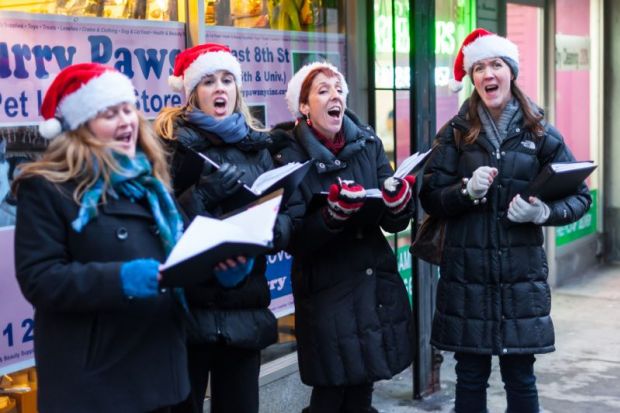Christmas is a time for nostalgia. We don our rose-tinted glasses and fondly remember Christmases past with the smell of roast turkey and chestnuts, anticipation of a visit by Father Christmas, tables groaning with rich food and drink and a roaring fire.
Whether it’s going out for family walks in the crisp snow or frost, diving into the sea, snuggling up over Christmas box sets and the Queen’s speech, or playing charades, we celebrate our winter festival with all kinds of traditions that bring people together and celebrate spreading messages of peace and joy. Music plays a central role in this nostalgia. While Christmas music is sometimes disliked for its ubiquity, particularly in public spaces, many of us have favourite Christmas songs that contribute to this connection to the past.
Prior to the 20th century and the advent of recorded music we depended on live music and singing. Carolling is a tradition that began in France and crossed the English Channel in the 16th century. Singers went from house to house (because they were banned from the church) and the tradition of carolling remains mostly in its original form today.
Most of our best-known carols date from Victorian times, such as O Come, All Ye Faithful (1843) and O Little Town of Bethlehem (1868). Some of the most loved carols were themselves nostalgic for their time. For instance, Jingle Bells, which dates from 19th century America (written by James Pierpont in 1857) drew on an older tradition of sleigh rides and songs which, as Boston University’s Kyna Hamil argued in her 2017 paper “The story I must tell”: “Jingle Bells” in the Minstrel Repertoire”, was clearly linked to the blackface minstrel tradition in Boston and New York. It was nostalgic, even when it was new, as well as racially insensitive.
Since the advent of recorded music, we have had access to a far greater range of music. But Christmas music still holds a privileged position, with Irving Berlin’s highly nostalgic White Christmas (from 1942) recognised as the best-selling song ever, with more than 100 million copies sold. The song drips with nostalgia – “I’m dreaming of a white Christmas, just like the ones we used to know” – and it has been part of Christmas celebrations for generations.
It’s perhaps no surprise that newcomers have difficulty gaining traction in the Christmas song market, as we seem to prefer old favourites such as Slade, Wizzard, Wham! and Mariah Carey (remarkably, Last Christmas, itself a mini-retrospective, is now 35 years old, and All I Want For Christmas Is You is 25 years old). More recent top-selling Christmas songs are often covers of old favourites by newer artists.
Part of the advantage these old favourites have is that their seasonality appeals to our natural mode of listening to music: obsession and repetition followed by abstinence. If we listened to “All I want for is Christmas is you” throughout the year its appeal would definitely expire, but constant repetition over a few months in winter actually works to maintain its popularity in the long term.
We see this pattern of waxing and waning preference for music in many other contexts. In my own research, people talk about going through periods of obsession and repetition with their favourites, followed by periods where they consciously put the music aside, eventually (but not always) coming back to it years later. We also know that music can be passed down from generation to generation, with our recent findings suggesting that today’s young adults have a particular fondness for music of their parents’ era and many memories of what might have been their parents’ favourites while growing up.
Nostalgia also coaxes us into suspending our modern values. Just like some of our favourite Christmas films (Love Actually springs to mind), our favourite Christmas songs don’t always strike the most appropriate tone, and yet we still seem to love them. Like our drunken uncle misbehaving, we tolerate lower standards when it comes to sexism at Christmas.
A recent example is the furore over Frank Loesser’s Baby, It’s Cold Outside, with its subtext of sexual pressure. The reaction eventually led to a new cover by John Legend and Kelly Clarkson this Christmas, which replaces pressure and coercion with support and choice. However, the rewrite has also sparked something of a backlash, with artists arguing that the original should be treated as sacrosanct: nostalgia for the original version, however politically incorrect, wins out.
So sleigh bells ringing, vast quantities of tinsel, fake snow and large dollops of nostalgia in Christmas music help provide a blanket of respectability over what might seem deplorable sentiments by 2019 standards.
Alexandra Lamont is senior lecturer in the psychology of music at Keele University.

